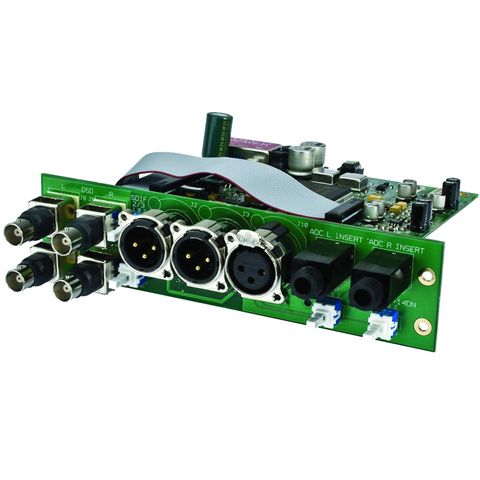
AMS Neve 8816ADC Digital Output Option Card
Description
The 8816ADC is a high-quality stereo analog-to-digital converter option card for the AMS Neve 8816 summing mixer that supports PCM sample rates up to 192kHz plus DSD, with sync inputs on AES3 and word clock.
Sample frequency can be selected by pressing the button to the right of the sample frequency LEDs. This will toggle through the sampling frequencies one at a time.
The 8816 has two sync inputs; one is a single AES3 female XLR), the other is word clock with a BNC connector. If no sync input is present, the 8816ADC will synchronize to its internal crystal clock. If one or the other sync inputs are present, the AES or WCK led will illuminate red showing that that sync input type is detected. When the correct sampling frequency is selected, either the WCK or AES led will light solid green to show that sync is being received and the unit has successfully locked to it. If both sync inputs are present and valid, the word clock input takes precedence over AES as the reference. Normally the sync input is set to the required sample rate. In this case both AES out 1/L and AES out 2/R carry the same stereo AES signal converted from the unit’s left and right analog outputs.
If the selected sample rate on the front of the unit is the same as the sync being input into the rear of the unit (48 kHz, either via word clock or AES sync), then the 2 XLR connectors on the rear of the ADC card will output Left and Right on both XLRs, so in effect a stereo mix on 1/L and the same stereo mix on 2/R.
It is also possible to select 96kHz (or 88.1kHz) sampling rate with a 48kHz (or 44.1kHz) sync input. Similarly, it is possible to select 192kHz (or 176.2 kHz) sampling rate with a 96kHz (or 88.1kHz) sync input. This will cause the unit to output double rate AES on the two AES Output connectors. The sync LED will illuminate green indicating the sync reference is still being used for the digital output even though the ADC is sampling at twice the sync input sampling rate.
In this situation, AES out 1/L carries the odd and even samples of the left audio double rate signal on its left and right digital channels respectively. Similarly, AES out 2/R carries the odd and even samples of the right audio double rate signal on its left and right AES channels.
Selecting DSD will default to 44.1kHz reference. If no sync is available it will use its own internal crystal reference. The interface requires a minimum of two BNC cables (DSD left and DSD right) to the DSD recording device. The DSD output is switchable between SDIF* 2 and SDIF 3 with a rear panel switch. SDIF 2 requires a 44.1kHz sync signal to be passed to the DAC and this should preferably come from the 8816 sync output via a third BNC cable. SDIF 3 transmits the DSD signals with clock information included and should not need the sync signal.
Key Features:
- PCM sampling rates from 24-bit/44.1kHz to 24-bit/192kHz
- DSD (direct stream digital) sampling
- Two sync inputs; AES3 on XLR-F and word clock over BNC connector
- Single- and double-wire AES3 output
- Internal crystal reference if no external sync is present
- Sample frequency selected from the 8816 summing mixer front panel
